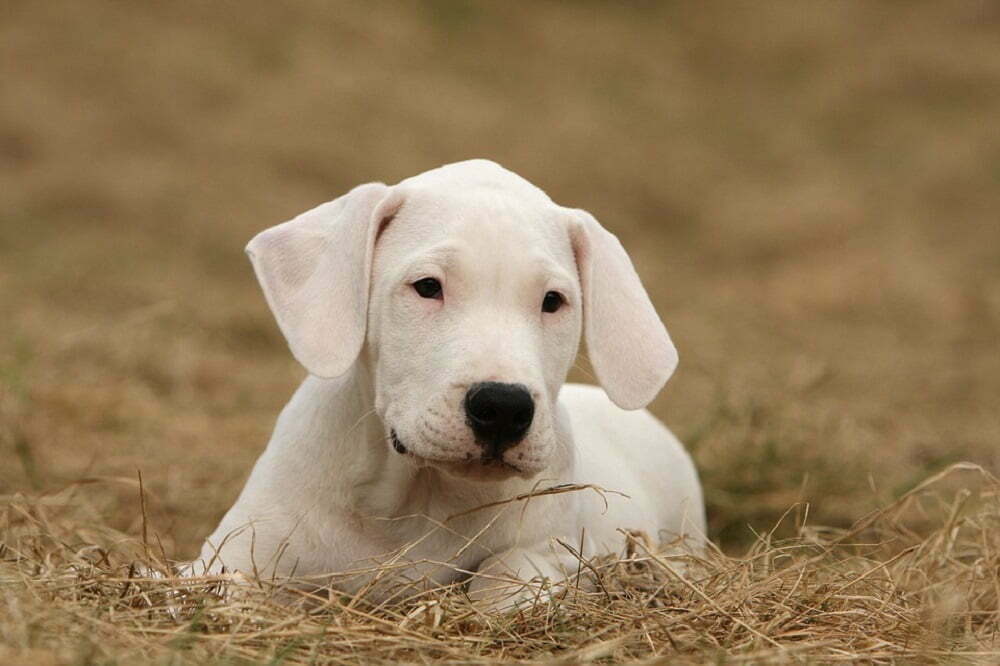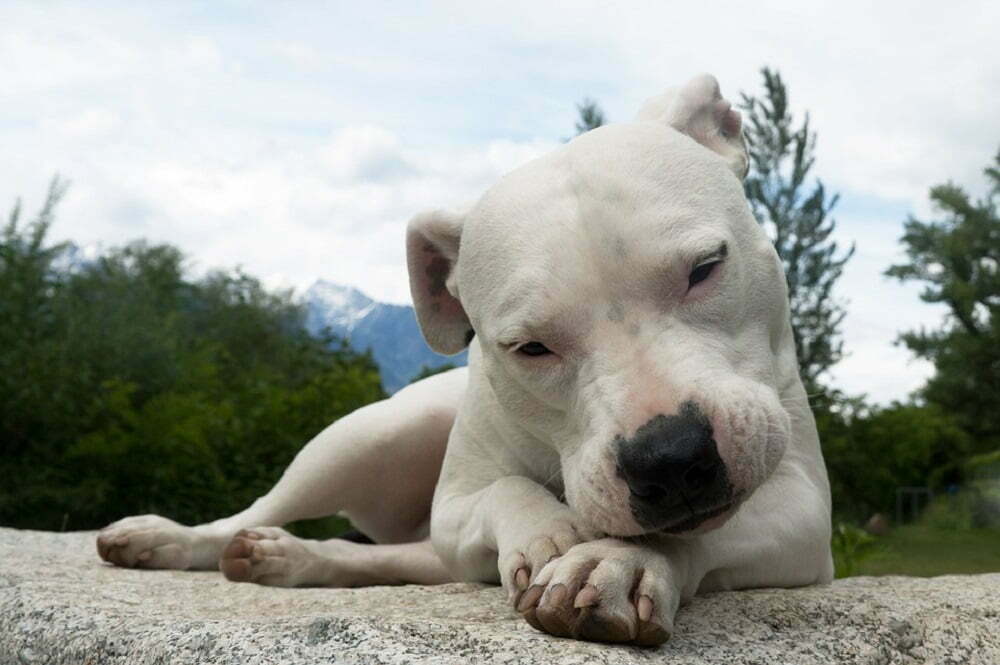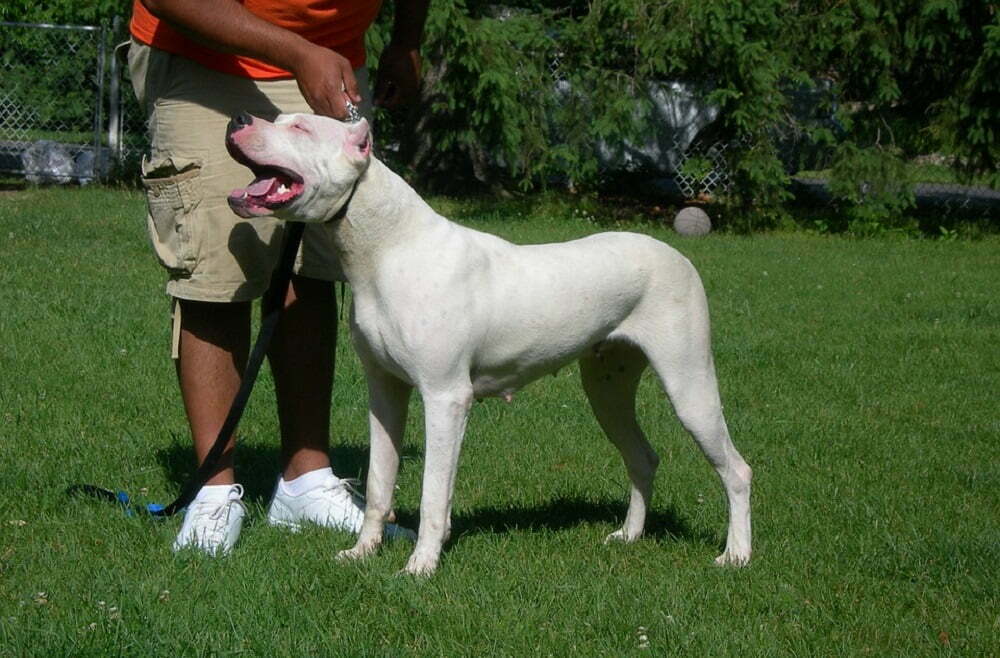If you’re a fan of large dog breeds, you’ll fall in love with Dogo Argentino. This Argentinian dog commands respect through its large frame and muscular build, yet has an affectionate, loyal, and protective temperament.
However, ownership of the Dogo Argentino breed has been banned in 11 countries, including the United Kingdom. In some areas of the U.S., restrictions are in place regarding this dog’s legality.

Keep reading to find out more about the history of Dogo Argentino, including why the breed is now banned in so many countries, and all the key information you need to know if you’re considering taking on one of these dogs.
Key Facts
Average Lifespan
The average lifespan for Dogo Argentino is 10 to 15 years. That’s quite a significant window, and the length of this breed’s life can be determined by many factors, including the amount of exercise they get on a daily basis and the quality of their diet.
Minimum Exercise (Per Day)
Dogo Argentino can get by on an hour’s exercise every day. However, if you want to provide the best quality of life for this dog, we recommend aiming for at least 90 minutes of exercise every day.
You can split this exercise time up into walks, jogs, and off-lead playtime. For example, the average Dogo Argentino will feel more satisfied after a high-energy session of fetch than a walk, although the latter is, of course, important.
Coat Length
The Dogo Argentino’s coat is short and smooth, making it easy to take care of and groom, as we’ll discuss further later in the article.
Minimum Cost (Per Month)
To cover dog food, insurance, and treats for a Dogo Argentino over one month, you can expect to spend $120.
This is not an amount to be taken lightly, so you’ll need to think carefully about whether you can afford the monthly expenses that come with a Dogo Argentino.
Appearance
Size
Dogo Argentino is a large breed, so as you might expect, it’s pretty imposing in terms of its size.
However, Dogo Argentino’s impressive size and weight (more on this below) aren’t the only things that make this breed so physically commanding. The Dogo Argentino has a huge potential for putting on muscle mass, which you’ll easily be able to see by looking at some pictures of the breed.
Average Height
As is the case with the majority of dog breeds, there is a difference in height between the average male and female Dogo Argentino.
The average male measures between 60 and 68 cm (at least a meter!) in height, while females usually fall somewhere between 60 and 65 centimeters. This is a less significant height difference than many other breeds.
Bear in mind that these measurements are taken from the withers, which is the slightly raised area between a dog’s shoulder blades. This means that the actual height of the Dogo Argentino, including the neck and head, is actually more than the provided figures.
Average Weight
The difference in weight between male and female Dogo Argentinos is clearer than the height difference.
Female Dogo Argentinos weigh between 35 and 40 kilograms, which means they can reach up to 88 pounds. Males of the breed average between 40 and 45 kilograms, which comes to a maximum of 99 pounds.
Temperament
Apartment Living
Assuming that the apartment in question is not too small to accommodate the movements of a Dogo Argentino, this dog can do quite well in an apartment living situation.
However, it’s best if the apartment has an outdoor area. You’ll also need to make sure that you’re giving your Dogo Argentino enough exercise in an outside space to counteract any possible claustrophobia and ensure its physical health.
Good for Novice Owners?
The Dogo Argentino is definitely not a breed suited to novice owners. These dogs are physically very strong in addition to being stubborn and independently minded.
Because of the combination of these traits, the Dogo Argentino can be extremely difficult for an inexperienced owner to train and handle.
Sensitivity Level
Dogo Argentinos are naturally protective dogs, and therefore, they are very tuned in to potential threats and changes in their surroundings. This can make them sensitive in the sense that they can display anxiety behaviors.
Moreover, a Dogo Argentino will be very sensitive when it comes to interactions with its owners. This breed is eager to please and, as a result, is very sensitive to disapproval or punishment from its owner.
Tolerates Being Alone?
The Dogo Argentino is likely to be unhappy about being left alone for a long time because it likes to be around its owners as much as possible.
This breed also becomes bored quite easily, which can spiral into destructive behavior. Therefore, leaving this dog alone a lot is definitely something to avoid.
Tolerates Cold Weather?
While Dogo Argentinos aren’t especially susceptible to the cold, the shortness of this breed’s coat means that it hasn’t adapted to spend a lot of time in cold temperatures.
Tolerates Hot Weather?
Thanks to its short coat, the Dogo Argentino is better suited to hot weather than it is to cold climates.
With that being said, it’s still not a good idea to leave your Dogo Argentino exposed to extreme heat. Of course, this is the case for any dog, because prolonged exposure to high temperatures can cause dehydration and lead to heatstroke.
Affectionate With Family?
The Dogo Argentino may have a reputation for being tough and dangerous, but it’s actually a loving and affectionate family dog.
However, the behavior of this breed around its family majorly depends on how well it has been trained. It’s crucial to diligently socialize and train this dog around humans while it is still a puppy.
Kid-Friendly?
When trained and socialized properly from an early age, the Dogo Argentino can learn to be gentle and friendly around children.
With that being said, you should never leave a Dogo Argentino unsupervised around children. Young children often lack a full understanding of the correct way to behave around dogs, and the Dogo Argentino’s powerful physique and bite force can present a danger should any interactions go wrong.
With the right training, however, a Dogo Argentino can make a trustworthy and protective companion for children.
It’s best to introduce a Dogo Argentino to children while both parties are still young.
Dog-Friendly?
Again, careful socialization is absolutely crucial to ensure that a Dogo Argentino is friendly to other dogs.
When trained correctly, this breed can have a very calm temperament, which bodes well for interactions with other dogs. However, they do have the potential to become aggressive with dogs that they don’t know.
We wouldn’t recommend having a Dogo Argentino around small dogs because of their prey drive. The same applies to cats and other small animals.
Friendly Towards Strangers?
The Dogo Argentino is a natural guard dog, which means that it is incredibly protective of its family. The consequence of this can be a wariness towards strangers.
However, as long as the dog has been trained and socialized well since puppyhood, unwarranted and excessive suspicion or aggression towards strangers can be curbed.
Health and Grooming

Shedding
Dogo Argentinos do shed quite heavily, but because their hairs are short, the shedding will feel much more manageable than that of some heavy-shedding, long-haired breeds.
Drooling
The Dogo Argentino has bigger jowls than many other breeds, so you can expect this dog to drool and slobber somewhat. However, it only typically does so an average amount, unlike some of its ancestors, which are very big droolers.
Grooming
Because of the Dogo Argentino’s size, the grooming process can feel quite extensive. However, due to the breed’s short coat length, Dogo Argentinos are actually pretty low-maintenance when it comes to grooming.
Weekly brushing is key to keeping your Dogo’s coat healthy and free from excess shedding. Once a week, use a natural bristle brush to get any loose hairs out of the coat and prevent matting (which, by the way, can happen even with short-coated breeds). This process will also help to keep your dog’s coat nice and glossy by re-distributing natural oils from the skin.
In addition to brushing, you should use this time to check around and inside the ears for damage or signs of infection. If necessary, you may also need to clip the dog’s nails, although if you’re providing your dog with the recommended 90 minutes of daily exercise for the breed, you may find that they are naturally wearing themselves down.
Where bathing is concerned, the Dogo Argentino doesn’t usually need to be bathed frequently. In fact, they can go as long as 3 consecutive months without a bath. However, it’s important for owners to use their best judgment to decide when to bathe this breed depending on how dirty the coat looks.
General Health
While the Dogo Argentino does not have as many health concerns as some other breeds, but because it is a purebred dog, it’s also not the healthiest breed out there.
The Dogo Argentino’s purebred status comes with an elevated risk of certain health conditions, which we will cover now.
Common Health Problems
Dogo Argentinos are disproportionately prone to deafness compared to other breeds. It’s estimated that as many as 10% of all Dogo Argentino puppies are actually born with hearing impairments.
Hip dysplasia is another condition that Dogo Argentinos may suffer from. This is a condition that affects many dog breeds and occurs when the hip socket is too small to cover the ball of the joint. This usually leads to either full or partial dislocation of the joint which, of course, is very painful for the dog and can have serious implications for mobility.
The Dogo Argentino also has a relatively high incidence of autoimmune thyroiditis. Autoimmune thyroiditis is an inflammation of the thyroid gland, often caused by the body mistakenly attacking the thyroid. This can lead to a variety of secondary health issues, including lethargy, obesity, and hair and skin changes.
Potential for Weight Gain
Because it is such a large breed, the Dogo Argentino needs to consume quite a lot of food every day. It also has high exercise needs. If exercise takes a back seat in a Dogo Argentino’s life and food intake remains the same, it’s easy for this breed to put on more weight than it should.
Moreover, as we mentioned in the previous section, the Dogo Argentino is prone to autoimmune thyroiditis. A side effect of this condition is weight gain that is not linked to any dietary changes.
Trainability
Easy to Train?
Dogo Argentinos love to please their owners, but they’re not an easy breed to train.
The reason why Dogo Argentinos need a firm, experienced hand during training is that they are pretty stubborn, which makes them generally less responsive to direct commands.
However, with plenty of positive reinforcement and love, a Dogo Argentino can be trained to be obedient and responsive.
Intelligence
The Dogo Argentino is certainly an intelligent dog breed, although they might appear to be less so according to most people’s standards of dog intelligence. This is mostly because people often consider dogs to be intelligent only if they are quick to learn and respond to commands, whereas a Dogo Argentino may be more stubborn.
However, rest assured that the Dogo Argentino is an intelligent dog that loves to interact and have lots of mental stimulation.
Potential to Bite
The bite force of the Dogo Argentino is estimated to be 500 PSI, which can do a lot of damage.
However, with diligent training and early socialization, the Dogo Argentino’s potential to bite will be greatly reduced.
Tendency to Bark or Howl
The Dogo Argentino is only an occasional barker. Usually, this breed will only bark when it feels the need to alert you to possible danger.
When this dog does bark, however, you’ll definitely know about it. It has a very deep bark that’s also pretty loud.
History

The history of the Dogo Argentino will be quite a sad one for dog lovers to hear, but knowledge of this breed’s history is important to promote an understanding of this dog’s temperament and reputation.
Dogo Argentinos date back to 1928, when they were bred by Dr. Antonio Nores Martinez in Cordoba, Argentina.
This breed’s lineage is quite complex because it involves some breeds that are now extinct. The main breed from which the Dogo Argentino is descended is the Fighting Dog of Cordoba. This breed is no longer in existence, but it was produced by crossing genetics from Bulldogs, Boxers, Bull Terriers, and Mastiffs.
However, the genetics of the Dogo Argentino have also been contributed to by the Bull Terrier, Irish Wolfhound, Great Pyrenees, Great Dane, Dogue de Bourdeaux, and the Spanish Mastiff.
The intention of Dr. Antonio Nores Martinez in creating the Dogo Argentino was to produce a dog that would be an effective big-game hunter.
Unfortunately, the fact that one of this breed’s parents was the Fighting Dog of Cordoba means that the breed does have some aggressive tendencies when proper training and socialization are neglected. This information has also led to a widespread misconception that the Dogo Argentino is, itself, a fighting dog, even though this is not the case.
As a result, the Dogo Argentino is now banned in a total of 11 countries, including the U.K., Norway, Iceland, Denmark, Turkey, Australia, Ukraine, Singapore, New Zealand, Fiji, and the Cayman Islands. There are also restrictions on Dogo Argentino ownership in many U.S. states.
Costs
It’s rare to find Dogo Argentinos in rescue shelters because they are purebred dogs, but some do end up in shelters after being taken in by owners who subsequently realize that they cannot provide adequate training and care for this breed.
Therefore, if you have your heart set on getting a Dogo Argentino, we would strongly recommend that potential buyers first look into the possibility of adopting.
Ethical issues aside, the cost of purchasing a Dogo Argentino puppy from a breeder is very steep. The average cost of a Dogo Argentino puppy is $3,000.
Trips to the vet and vaccinations can add up to $1,100 per year, while the cost of food alone is likely to set you back $700 on a yearly basis.
During your puppy’s first year, you’ll also need to pay for training, which may need to be more extensive for this breed than others. You should budget $200 for this.
When you add in the cost of grooming, insurance, and essential items such as beds, bowls, a leash, a crate, a collar, and toys, your total expenses for the first year can easily add up to $7,000 on average.
Following years will be less expensive, but still costly, at a yearly average of $3,385.
Fun Facts
- The Dogo Argentino can run very fast, reaching top speeds of 25 miles per hour, or 40 kilometers per hour.
- Dogo Argentinos produce large litters of 8 to 10 puppies on average.
- The Dogo Argentino can sometimes feature a black spot on its head called a pirata.
